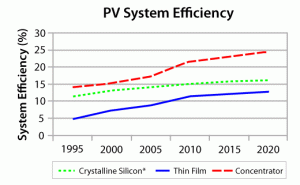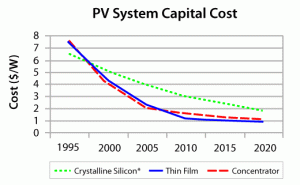DIFFERENT TECHNOLOGIES
Solar photovoltaics were first used in 1839 when a French physicist, Alexandre Edmond Becquerel, discovered that light can be converted into electricity when he experimented with metal electrodes and electrolytes. In 1873, Willoughby Smith made a discovery of photovoltaic effects in selenium. In 1887, Heinrich Hertz discovered that voltage can be changed at which sparks between two metal electrodes would be initiated, via ultraviolet light. The first silicon solar cells were not discovered until 1918, when Jan Czochralski, a Polish scientist, discovered that a monocrystalline silicon can be used for solar cell production upon the discovery of the method of the production of monocystalline silicon itself. The first solar cell using silicon monocrystalline was constructed in 1941. [1]
Early silicon solar photovoltaic sells did not, however, have good efficiency. In addition, running them were a bit costly. However, as time passes, efficiency increased while the cost decreased. In 1955, Hoffman Electronics-Semiconductor Division introduced photovoltaic products with only a 2% efficiency, with an energy cost of $1,785/Watt (USD). In 1957, Hoffman Electronics were able to introduce cells with an increased efficiency, at 8%. The same company’s solar cell efficiency was increased to 9% in 1958 and 10% in 1959. The efficiency skyrocketed to 14% in 1960. In 1985, researchers at University of New South Wales, Australia were able to construct a solar cell that has over 20% efficiency. A 20% efficiency solar cell were patented in 1992.
In the 21st century, the efficiency continues to rise and and the future forecast shows that there are no signs that the efficiency would stop increasing. In addition, the cost of solar energy has been decreasing. [2],[3]
The two graphs below show the average PV system efficiency and the capital costs over time for the three different types of PV cells in the US: Crystalline Silicon, Thin Film and Concentrator. The efficiencies for all three types have been increasing and are projected to increase further into 2020. Concentrator has the greatest amount of efficiency as the average efficiency is projected to hit 25% in 2020. [2], [3]


NATIONAL RENEWABLE ENERGY LABORATORY (NREL) RESEARCH
The figure below presents data accumulated and published at the National Center for Photovoltaics under NREL and shows the efficiency for various solar PV technologies under development and research over time. A number of interesting trends can be drawn from the figure. Firstly, although most solar PV arrays currently use vary in efficiency from around 10-20% [4], efficiency values as high as 44.4% have been obtained in experimental settings by Sharp and NREL. However, most of the technologies at these high efficiencies have only been possible under laboratory settings and not at full scale production level. It is interesting to observe that on average over time, the efficiency for all the four technologies considered have increased proving that solar PV is on an upward trajectory as far as improving the efficiency is considered. On a final note, it is particularly revealing to identify that most of the technologies at efficiency higher than ~25% are those developed by large private corporations such as Boeing, Panasonic and Sharp possibly because of the financial resources available to them and the more tangible, short-term incentives of maximizing profits and cutting costs. [5]

Author: Amos Han
Editor: Apratim Mukherjee
Extremely intriguing and insightful tips. Bookmarked ! Thanks for the amazing read.
Hello, constantly i used to check website posts here in the
early hours in the break of day, as i enjoy to learn more and
more.
It’s incredible to think how far solar technology has come in terms of both costs and efficiency! Imagine when 44.4% efficiency is commonplace – we’ll only need 10 panels on the roof for a 5kW system! This will open whole new avenues of potential ways to utilise solar power – especially if the costs continue to fall.
The future is driven by nano engineering. Look at LED lights, LED t.v. and OLED t.v. research, lasers, chips, and you will see solar p.v.
will benefit from research in these. Indium gallium nitrides can be tuned to the solar spectrum with 2-5 layers array to get 30% -60%
conversion of light to electricity. Costs come down, efficiency up, and demand increases. The California wind started and was a tax
writeoff and not real electricity, Enron with buy low sell high to consumers made electricity to high ($80,000/yr. secretary salaries)
and bankruptcy. Calpine energy the president retired with $20,000,000.00 (of my money) so the problem is with greed not the pv.